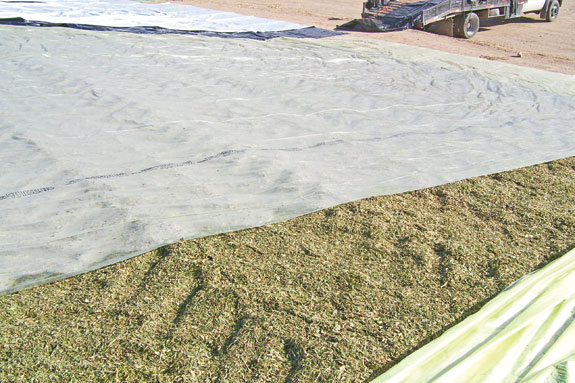With rising commodity costs, it is increasingly important to protect and preserve feed quality from harvest to feedout. The period prior to spring planting provides an opportunity for producers to evaluate current silage management practices and explore options to improve this year’s crop storage.
Packing, covering, feeding out and visually assessing silage quality are areas to pay close attention to. Evaluation gives producers a starting point to set goals and measure success during the coming year.
In an ideal world, the many factors that influence forage quality during harvest and storage would be easily adjusted for. Unfortunately, that is not the case, and producers must make it a priority to manage as many variables as possible that affect ensiled forage.
Dirk Appel, co-owner of Spruce Lane Dairies Ltd., along with his wife, Elizabeth, strives to do just that. They, along with their son, run a dairy farm near Red Deer, Alberta, consisting of 240 registered Holsteins under the prefix Altappel.
More than 14 years ago, the Appels settled in the province after moving from Holland, and today they manage the overall dairy operation and feed program. Spruce Lane Dairies and the Appels pride themselves on top-quality forage and effective management of their 600 acres of land, on which they plant cereal barley for silage, alfalfa and corn.
Packing details and cover options
The first step towards efficient forage preservation is timely packing and covering of bunker silos or drive-over piles. Appel achieves this by allowing enough time to properly pack forage in his bunker silos to achieve a high silage dry matter (DM) density.
According to Kansas State University’s silage team, 16 pounds of DM per cubic foot is the target for packing density to minimize shrinkage loss.
The Spruce Lane Dairies operation uses two weighted tractors to pack in the four concrete bunker silos; one tractor is operated by a custom harvester, while the other is driven by a Spruce Lane Dairies employee. When working with custom operators, Appel says it is important to communicate so everyone knows exactly what the silage density target is.
After packing, timely covering of the bunker silos is necessary for efficient fermentation and to protect silage at the surface from the detrimental effects of oxygen. For the past three years, Appel and his crew have utilized a two-step approach when covering their four bunker silos which includes the application of a clear oxygen barrier film followed by a sheet of six-mil standard plastic.
Before completely incorporating the two-step approach with the oxygen blocking film product into his forage storing program, Appel conducted his own on-farm field trial.

During Spruce Lane Dairies’ trial, three bunker silos were covered by a basic, single sheet of black and white plastic, and the fourth bunker received the two-step cover of the clear film followed by one layer of the same black and white plastic used on the other three bunkers.
The comparison allowed Appel to evaluate the performance versus the cost of the added investment. In the end, the two-step approach proved to be an effective silage management tool for Spruce Lane Dairies by reducing spoilage and shrink loss.
Silage feedout management
Maintaining silage quality doesn’t end after covering, when the last tire or gravel bag is in place. During feedout, proper face management is essential to protect feed quality and ensure the safety of employees.
A smooth, straight feedout face can be achieved using a shaver or facer. Feedout rate varies by season; during the winter months, at least six inches daily should be removed, and at least 12 inches daily during warmer months.
When feeding from a bunker silo or drive-over pile, it’s important to ensure the leading edge of the cover remains in close contact with the silage to minimize heating and spoilage. This can be accomplished by using gravel bags to seal the edge and prevent oxygen from reaching the silage surface.
Proper face management is more than simply feeding silage to the cow herd. Employee safety is an important concern. The silage feedout face should never be higher than the equipment can reach, and no one should ever stand closer to the silage face than twice its height.
Evaluating an operation’s face management practice might uncover safety hazards like unstable face sections, as well as forage quality concerns. Take precautions to prevent injury or even death at all times during feedout. Every step of forage management has safety issues and should be approached with an informed and alert mind.
Visual quality checks
Visual quality checks should be taken daily during storage and feedout. Vermin, rodents, birds and hail can cause damage to the covering materials and allow oxygen to spoil silage at the feedout face or surface of bunker silos and piles.
Holes in the cover should be promptly patched with repair tape. During visual evaluation, make a point to inspect the tires and gravel bags, which can be displaced as forage settles during the fermentation and storage periods.
Hail storms are common in Alberta and cause damage to the plastic covering bunker silos and drive-over piles. At Spruce Lane Dairies, Appel credits the two-step covering system with providing an extra layer of protection between nature’s wicked weather and his valuable forage. Visual checks of the plastic are still necessary, but the extra layer adds some additional protection against the weather.
Conclusion
Evaluation of silage management practices and willingness to conduct on-farm trials has increased cow herd efficiency at Spruce Lane Dairies. For Appel, the implementation of a two-step covering method has positively affected more than just feed quality.
With decreased surface spoilage in the bunker silos, aerobically deteriorated silage rarely makes it into the feed bunk, saving the operation from detrimental effects on herd health and milk production. PD
PHOTOS
For the past three years, Dirk Appel, co-owner of Spruce Lane Dairies Ltd., and his crew have utilized a two-step approach when covering their four bunker silos, which includes the application of a clear oxygen barrier film followed by a sheet of six-mil standard plastic. Photos courtesy of SiloStop.








